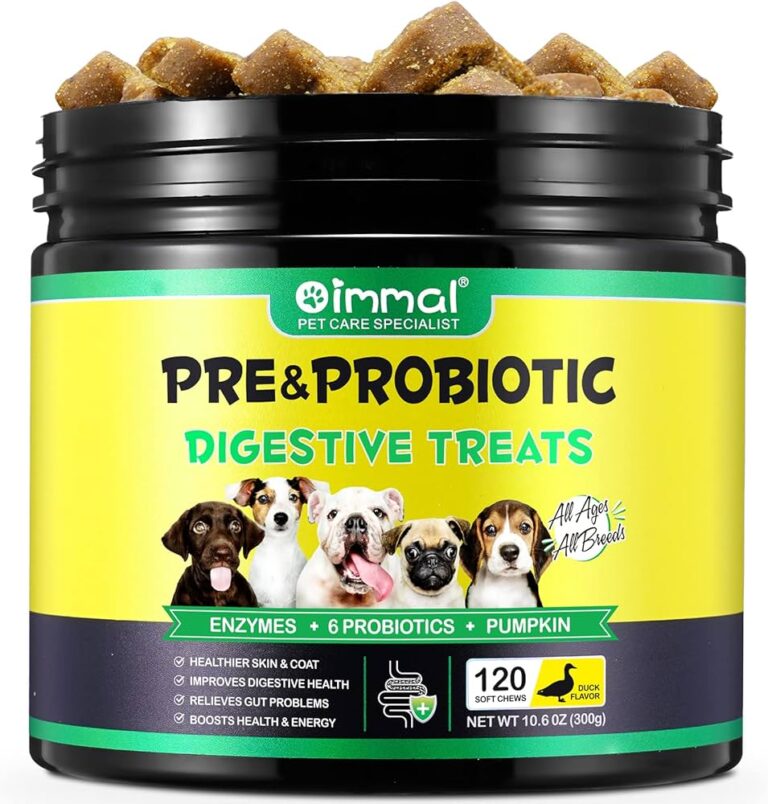For dogs with diarrhea, give 1-4 teaspoons of plain pumpkin puree per meal. If your dog is experiencing bouts of diarrhea, you may be wondering how much pumpkin to give them for relief.
Pumpkin can be a helpful natural remedy for dogs with digestive issues due to its high fiber content. One to four teaspoons of plain pumpkin puree per meal is generally recommended to alleviate diarrhea symptoms. However, it’s important to consult your veterinarian before adding pumpkin to your dog’s diet, as they can provide more tailored dosage instructions based on your dog’s specific needs.
We will discuss the benefits of pumpkin for dogs, how much pumpkin to give, and other important considerations to keep in mind when using pumpkin as a remedy for diarrhea.

Credit: www.pumpkin.care
Why Pumpkin Is Beneficial For Dogs With Diarrhea
Pumpkin can be beneficial for dogs with diarrhea as it helps soothe their upset stomach and regulate their digestion. To determine the amount of pumpkin to give, consult with your veterinarian based on your dog’s size and condition.
Understanding The Benefits Of Pumpkin
When it comes to taking care of our furry friends, their health and happiness are our top priorities. If your dog is experiencing diarrhea, you may be wondering how to alleviate their discomfort. While there are various remedies available, one natural and effective solution is pumpkin. Not only is pumpkin safe for dogs, but it also offers several benefits that can help soothe your pet’s digestive system and ease their diarrhea. Understanding why pumpkin is beneficial for dogs with diarrhea can provide you with the knowledge you need to assist your furry friend in feeling better.The Role Of Pumpkin In Stabilizing A Dog’s Digestive System
Pumpkin is loaded with essential nutrients and fibers that play a crucial role in stabilizing your dog’s digestive system. The high content of fiber in pumpkin helps regulate bowel movements, preventing both constipation and diarrhea. Additionally, pumpkin acts as a gentle laxative, softening the stool and making it easier for your dog to pass. This can be especially helpful if your dog is experiencing bouts of loose stools or diarrhea. Incorporating a small amount of pumpkin into their diet can aid in normalizing their digestive process and promoting regularity.How Pumpkin Helps Ease Diarrhea In Dogs
Pumpkin possesses gentle yet powerful properties that can effectively ease diarrhea in dogs. The soluble fiber in pumpkin acts as a bulk-forming agent, absorbing excess water in the digestive tract and firming up loose stools. This fiber also acts as a prebiotic, providing nourishment for beneficial gut bacteria. A balanced gut microbiome is essential for proper digestion and overall digestive health. Furthermore, pumpkin contains high levels of vitamins A, C, and E, which are antioxidants that promote healing and reduce inflammation in the digestive system. These combined benefits make pumpkin an ideal companion for dogs dealing with diarrhea. In conclusion, pumpkin is a safe and natural remedy that can significantly benefit dogs suffering from diarrhea. Its high fiber content helps stabilize the digestive system, while its gentle laxative properties aid in regulating bowel movements. The soothing effects of pumpkin on the gut, along with its prebiotic properties and antioxidant-rich composition, make it an effective solution for easing diarrhea in dogs. By understanding the numerous benefits pumpkin offers, you can confidently incorporate this nutritious ingredient into your furry friend’s diet to promote digestive health and overall well-being.
Credit: www.amazon.com
Determining The Right Amount Of Pumpkin To Give
Determining the appropriate amount of pumpkin for a dog with diarrhea is crucial. It is best to start with small, incremental doses and observe the effects on their digestive system. Gradually increase the amount until you find the right balance that helps alleviate their symptoms.
Consulting A Veterinarian For Proper Dosage
Determining the right amount of pumpkin to give to a dog with diarrhea is crucial in order to alleviate their symptoms and promote healthy digestion. While pumpkin is generally safe for dogs, it is important to consult a veterinarian for proper dosage. Veterinarians have the expertise to assess your dog’s condition and recommend the correct amount of pumpkin based on their unique needs. They can consider factors such as the severity of the diarrhea and any underlying health conditions your dog may have. Therefore, do not hesitate to reach out to your trusted veterinarian before starting your dog on a pumpkin regimen.Considering The Size And Weight Of The Dog
Another key factor to take into account when determining the amount of pumpkin to give a dog is their size and weight. Larger dogs will typically require a higher dosage compared to smaller breeds. It is crucial to consider that the size and weight of a dog can significantly impact their metabolism and digestive system. Therefore, it is essential to adjust the pumpkin dosage accordingly to ensure its effectiveness in treating diarrhea.Calculating The Correct Amount Of Pumpkin Based On Weight
To accurately calculate the correct amount of pumpkin to give your dog, you can use a simple formula based on their weight. A general guideline is to administer 1-4 tablespoons of pumpkin per 10 pounds of body weight. For example, a 20-pound dog would receive 2-8 tablespoons of pumpkin. However, it is important to remember that this is just a starting point and the dosage may need to be adjusted based on your dog’s response and the guidance of your veterinarian. To illustrate the calculation further, take a look at the table below:| Weight of Dog (in pounds) | Approximate Pumpkin Dosage (in tablespoons) |
|---|---|
| 10 | 1-4 |
| 20 | 2-8 |
| 30 | 3-12 |
| 40 | 4-16 |
Introducing Pumpkin Into A Dog’s Diet
Introduce pumpkin into your dog’s diet to help soothe diarrhea. Give a small amount, such as 1-4 teaspoons per meal, depending on your dog’s size, to see how they respond.
Gradually Incorporating Pumpkin Into Dog’s Food
To introduce pumpkin into a dog’s diet, it is crucial to do so gradually. This gradual incorporation helps your furry friend adjust to the new addition and aids in preventing any further digestive upset. Start by adding a small amount of pumpkin to your dog’s regular food. Observe how your dog responds over the next few days. If there are no adverse effects, gradually increase the amount of pumpkin in their diet.Choosing The Right Type Of Pumpkin
When it comes to choosing the right type of pumpkin for your dog, it is best to opt for plain, canned pumpkin without any additives or sweeteners. Pure pumpkin packs a nutritional punch and is high in fiber, aiding digestion for your dog. Make sure to avoid pumpkin pie filling or spiced pumpkin products, as they may contain harmful ingredients like xylitol and spices that can upset your dog’s stomach.Monitoring The Effectiveness Of Pumpkin In Diarrhea Management
Monitoring the effectiveness of pumpkin in managing diarrhea is essential. Keep an eye on your dog’s bowel movements and overall well-being. If your dog’s diarrhea persists or worsens despite the incorporation of pumpkin, it may be time to consult your veterinarian. They can provide further guidance and determine if any underlying health issues need to be addressed. To summarize, when incorporating pumpkin into a dog’s diet, gradual introduction is key. Choose plain, canned pumpkin without any additives or sweeteners. Monitor your dog’s response and consult your veterinarian if diarrhea persists or worsens. Remember, each dog is unique, and what works for one may not work for another. Stay attentive to your furry companion’s needs, and with the right approach, you can help manage their diarrhea effectively.
Credit: www.pumpkin.care
Frequently Asked Questions For How Much Pumpkin To Give A Dog With Diarrhea
How Fast Does Pumpkin Work For Dog Diarrhea?
Pumpkin works quickly to ease dog diarrhea. It helps firm up stool by regulating digestion. Give 1-4 tablespoons daily, depending on the dog’s size. Always consult your vet before adding pumpkin to your dog’s diet.
Is Pumpkin Or Rice Better For Dogs With Diarrhea?
Pumpkin is better for dogs with diarrhea than rice because it is high in fiber and can help firm up their stool. Rice, on the other hand, may not be as effective in relieving diarrhea.
Can You Give A Dog Too Much Pumpkin?
Yes, you can give a dog too much pumpkin. It can cause digestive issues like diarrhea or upset stomach. Offer pumpkin in moderation to avoid any problems.
Will Pumpkin Settle A Dog’s Stomach?
Yes, pumpkin can settle a dog’s stomach due to its high fiber content. It helps with digestive issues like diarrhea and constipation. Start with a small amount and gradually increase. However, consult your vet before adding any new food to your dog’s diet.
Conclusion
To sum up, giving pumpkin to a dog with diarrhea can be an effective remedy due to its high fiber content and soothing properties. It can help regulate their bowel movements and provide relief. However, it is crucial to consult with a veterinarian and follow the appropriate dosage based on your dog’s size and condition.
Remember, the well-being of your furry friend is paramount, so always prioritize their health and seek professional advice when needed.



